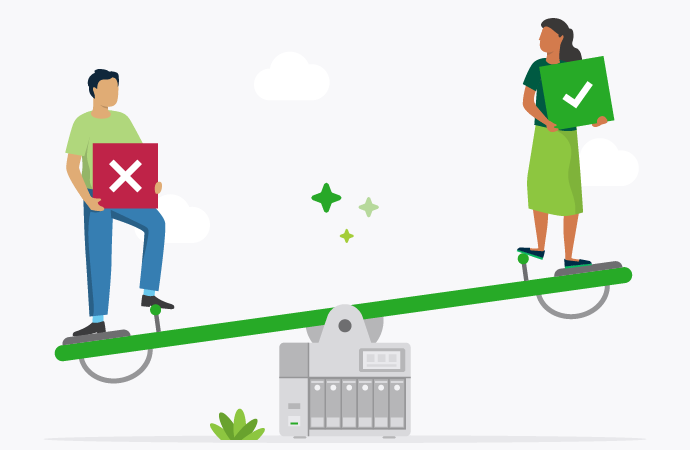When it comes to print management in an organization, you’ve basically got two choices: you can run a centralized print server, or connect each workstation directly to a printer (using a printer’s unique IP address).
Neither of these is ‘correct’, although you certainly see a lot more print servers than direct IP environments these days. As with anything, it comes down to your business objectives and the capabilities you value.
Are you more interested in efficiency or reliability? Security or simplicity? Let’s run through the pros and cons of having a print server.
What is a print server?
A print server is a centralized computer application or physical device that manages print jobs from multiple computers. It queues all your print requests and fields them out to the appropriate printer.
Think of it as a modern version of the old switchboard operator, connecting users and the network.
Pros of a print server
Centralized management
This is really the slam-dunk argument for having a print server. It gives your IT team a single location from which to manage, update, and configure all printers on the network.
More advanced features
Print servers allow for more advanced print settings, such as load balancing , print quotas, and print job prioritization. All the stuff that makes your print environment more efficient.
Simplified installation
With a print server, users can automatically access any printers on the network, without needing to manually configure every and every device. Good for large print environments.
Enhanced security
Print servers generally have way more robust security features, including multi-factor authentication, print audits, and
secure print release
.
For some companies, this will be the end of the debate.
Cons of a print server
Single point of failure
If the print server goes down, that means no more printing. Of course, there are backups and disaster recovery measures you can put in place.
For more info, check out our tips for High Availability .
Performance bottlenecks
In high-demand print environments, print servers can become overloaded by print requests, slowing performance and affecting your output. Scaling servers is an easy fix there.
High IT overheads
Less relevant for cloud-print environments , but physical print servers generally do require a fair bit of IT maintenance and troubleshooting. It’s one reason many companies have migrated to the cloud in recent years.
Initial setup and cost
Again, this differs depending on cloud v on-premise print servers, but you do need to factor in setup cost for print servers. Especially for smaller companies with limited IT resources.
What is direct IP printing?
Direct IP printing simply means that each workstation is connected to a printer using that printer’s unique IP address. In these environments, everyone’s computer can communicate with a printer, without relying on a centralized server.
Pros of direct IP printing
Reliability
This is where direct IP printing still has a minor edge. With no single point of failure, it’s very unlikely that your entire print network will go offline, which could be useful in environments requiring high availability.
Reduced IT management
This isn’t as simple as it sounds. Yes, direct IP requires less centralized oversight, but it also means IT can’t easily monitor usage or configure devices. Swings and roundabouts.
Faster processing
As a rule, direct IP printing tends to be slightly faster than servers (particularly busy servers), since print jobs only need to travel from the computer to the printer. No delays or server-based queues.
Cost-effective
Translation: cheap. Direct IP printing needs no additional hardware licensing or maintenance, making it ideal for smaller businesses that are just looking to cut costs.
Cons of direct IP printing
Limited control
A big one. Without a centralized print server, there’s no way for IT to monitor usage, enforce print policies, track and log print jobs, or apply quotes. You’re basically handicapping your own performance.
Manual configuration
Another major drag. With direct IP printing, users or staff must manually configure printers on every device. This is obviously time-consuming, and almost impossible to manage in larger organizations.
Limited security features
Direct IP printing lacks the more sophisticated security tools of most print servers, like secure print release and job tracking. Employees are more or less free to set their own print policies. Which is… yeah, not ideal.
Network strain
Since every workstation is still connected to a printer via the network, direct IP printing can lead to network congestion and affect performance, especially in larger setups.
Which to choose?
The vast majority of organizations are going to value the control, oversight, and security features of server-based printing. They’re just too valuable to pass up.
Direct IP printing still has a place, but we’d generally only recommend it for very small businesses, perhaps with a single MFD, who want to keep costs minimal and aren’t interested in any bells and whistles.
However, at the end of the day, you have to evaluate what’s important for your business. Centralized control? Security features? Reliability? Bare basics?
Pick the print setup that’s right for you.
Need help choosing?
We’ve got you – fill out the form below and our team will reach out to you to help you choose the best solution for your business’s needs, and get you up and running.

Speak with Sales
Need a little help from a human? Speak with us, we don’t bite.
By filling out and submitting this form, you agree that you have read our Privacy Policy, and agree to PaperCut handling your data in accordance with its terms.
This site is protected by reCAPTCHA and the Google Privacy Policy and Terms of Service apply.




